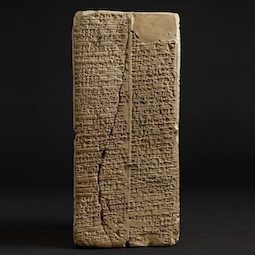The Sumerian King List
The Sumerian King List is a text written in Sumerian which lists cities, their rulers, and the number of years each of them reigned. This latter aspect has made this text especially famous because many rulers are recorded as having reigned from several hundreds to several thousands of years, for example Gushur, king of Kish, who reigned for 1,200 years, or Ku-Baba, Queen of Kish and a former tavern-keeper, who ruled for 100 years.
 [/kish/images/skl-large.jpg]
[/kish/images/skl-large.jpg]The most famous and complete manuscript of the Sumerian King List is the so-called Weld-Blundell Prism. It was one of many hundreds of cuneiform tablets that Herbert Weld-Blundell, the OFME's primary financial backer, bought from dealers and excavators in Iraq while scouting for archaeological sites. The whole collection is now in the care of the Ashmolean Museum, Oxford. Source: AN1923.444 [https://www.ashmolean.org/collections-online#/item/ash-object-462921], Ashmolean Museum.
Ever since the first manuscripts of the Sumerian King List were deciphered, this text has fascinated readers because we have no modern categories that can fully describe it. This composition reads like a historical chronology, because it lists names known from other historical documents, but to the modern reader it also seems to contain elements of fiction. The first part of the Sumerian King List is filled with figures known from myths and legends, such Dumuzi, the husband of the goddess Inanna, and Etana, the king who flew to the heavens on an eagle's back in search of the plant of birth. Even the later sections of the King List maintain the fiction that only one city ever "held kingship" at a time, though we know from other sources that there were often rival dynasties competing for power in the third millennium BC.
Before and after the Flood
The city of Kish features prominently in the Sumerian King List as it is recorded as the first city of kings, a gift bestowed by the gods "after the great Flood swept over the world" - the flood known in later religious texts such as the Bible (Book of Genesis) and the Quran (Surah 11; 71). This mythical event was central to the early Mesopotamian concept of the past, as it was considered to have been caused by the gods in order to manage down the human population.
Before the Flood, the Sumerian and Babylonian narratives tell us, there was no disease or natural disaster, so humans lived for many thousands of years. We see these supposed lifespans recorded in the first, antediluvian, section of the Sumerian King List too, where kingship first descended "from the heavens" to the city of Eridu. Kish was not among the five cities which held kingship before the Flood "swept over". After the Flood, the myths tell us, the Mesopotamian gods introduced sickness, miscarriage, plague and famine into the world, in order to reduce human lifespans.
The numbers in the Sumerian King List suggest that this was a gradual process. For when kingship was first transferred to Kish, its rulers reigned for a total of 24,510 years, until the last king of Kish, Aga. After Kish, kingship was sent to the E-ana, the temple of the goddess Inanna at Uruk, echoing the narrative in "Gilgamesh and Aga".
In total, Kish held kingship during five separate dynasties after the Flood, until Ur-Zababa gave way to Sargon of Akkad and his successors, as recounted in "Sargon and Ur-Zababa".
The history of the Sumerian King List
All surviving manuscripts of the Sumerian King List date to the Old Babylonian period, except for one example which dates to the reign of king Shulgi, in the Ur III period (c. 2100 BC). While manuscripts of the composition vary greatly in their start and end points, and the order and lengths of individual kings' reigns, the latest end in the early second millennium with the kings of Isin as the last dynasty. Some copies of the list also contain a final part which summarises the total number of kings and of their regnal year.
The Sumerian King List first came to the attention of Assyriologists in 1906 and 1911 after scholars purchased fragments from Nippur and Kish (Tell Uhaimir) from Iraqi antiquities dealers. Several fragments of the list were later found in various ancient cities across Iraq, mostly in the south. But the best preserved and most beautiful example is a four-sided prism known as the "Weld-Blundell prism".
Herbert Weld-Blundell PGP , the wealthy philanthropist who funded the OFME excavations between 1923 and 1932, bought the prism while visiting the ruins of Larsa in early 1922, on the scouting trip that led him to choose Kish to excavate. This manuscript is today at the Ashmolean Museum [https://www.ashmolean.org/sumerian-king-list] in Oxford, UK.
- Read an English translation of "The Sumerian King List" [https://etcsl.orinst.ox.ac.uk/cgi-bin/etcsl.cgi?text=t.2.1.1#] on the Electronic Text Corpus of Sumerian Literature (ETCSL 2.1.1)
20 Oct 2025
Nadia Aït Saïd-Ghanem & Eleanor Robson
Nadia Aït Saïd-Ghanem & Eleanor Robson, 'The Sumerian King List', The Forgotten City of Kish • مدينة كيش المنسية, The Kish Project, 2025 [http://oracc.org/KingsandLegends/SumerianKingList/]